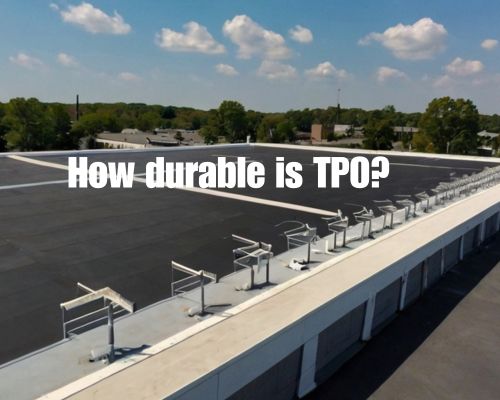
Examining Longevity and Performance
Thermoplastic Polyolefin (TPO) roofing stands out in the world of commercial roofing for its exceptional durability.
This single-ply roofing membrane is designed to withstand a variety of environmental stressors, making it a reliable choice for many property owners.

TPO’s flexibility allows it to handle the natural contractions and expansions caused by temperature fluctuations, minimizing damage over time.
Charles Jimerson from CJ Commercial Roofing NJ highlights that with proper maintenance, TPO roofs can last anywhere from 20 to 30 years.
This longevity is attributed to its strong, heat-welded seams, which are far more resilient than glued or taped seams found in other roofing types.
Additionally, TPO is also highly resistant to punctures and tears, further enhancing its durability.
TPO’s ability to resist harsh weather conditions, including strong winds and hail, makes it suitable for various climates.
Whether installed on flat or slightly sloped roofs, this versatile material ensures reliable performance and protection for your building.
Composition and Properties of TPO
Thermoplastic Olefin (TPO) is a versatile material known for its blend of durability and flexibility. It incorporates specific components that give it unique properties such as heat resistance and energy efficiency.
Basic Composition
TPO typically consists of a combination of thermoplastic, rubber, and filler materials.
The thermoplastic component, usually polypropylene, provides the material with its formability and reprocessability. Meanwhile, rubber elements, often ethylene-propylene rubber, add elasticity and impact resistance.
Fillers, such as talc or fiberglass, enhance the material’s strength and stiffness.
This blend offers a robust balance of properties that make TPO suitable for many applications.
Flexibility and Heat Resistance
TPO is prized for its flexibility, allowing it to withstand significant deformation without cracking. This flexibility is particularly valuable in applications exposed to continuous movement and stress.
Additionally, TPO exhibits excellent heat resistance, maintaining performance under high temperatures.
It can endure prolonged UV exposure without degrading, making it ideal for roofing and outdoor applications.
The heat resistance also contributes to its stability and long lifespan in demanding environments.
Energy Efficiency
One of the standout features of TPO is its energy efficiency.
For example, TPO roofs have reflective properties that help reduce energy consumption by reflecting sunlight and heat away from buildings.
This reflective quality aids in maintaining cooler indoor temperatures, leading to lower cooling costs.
Moreover, TPO’s insulation capabilities further enhance its energy-efficient profile, providing better thermal regulation and energy savings.
Lightweight as well, TPO installations often require less structural support, contributing to overall resource efficiency.
Durability Factors and Maintenance
Thermoplastic Polyolefin (TPO) roofing is known for its sturdy design and ability to withstand various environmental factors.
Key areas of durability include resistance to elements, lifespan, and maintenance requirements, each crucial for maximizing the roof’s performance.
Resistance to Elements
TPO roofing is designed to resist numerous environmental challenges.
Its composition offers robust protection against UV radiation, reducing material degradation over time.
The reflective surface helps to maintain lower rooftop temperatures, which can further safeguard the material from heat-induced damage.
This type of roofing exhibits strong resistance to tears and punctures, making it suitable for areas with heavy foot traffic or potential debris impact.
It also holds up well against chemical exposure, ensuring it remains durable in varying weather conditions.
Extreme weather like high winds and hailstorms also test TPO’s resilience, but its flexible nature allows it to absorb and resist such impacts effectively.
Lifespan and Wear
The expected lifespan of a TPO roof ranges from 20 to 30 years with proper installation and maintenance.
Variations in geographic location and weather patterns can influence this duration.
TPO’s wear resistance comes from its thick, flexible membrane, which can be tailored during installation. For instance, thicker membranes offer greater durability but may come with higher costs.
Consistent exposure to sunlight and UV rays can eventually cause wear, but the material’s inherent UV resistance can slow down this process significantly.
Regular inspections and monitoring are essential to track the wear and tear so that the necessary actions can be taken timely. See Charles Jimerson from CJ Commercial Roofing NJ for any roofing works.
Repair and Maintenance
To ensure prolonged durability, regular maintenance is vital.
This includes clearing debris to avoid punctures and inspecting for any signs of wear or damage.
Routine roof maintenance should incorporate checks for tears and punctures, especially after severe weather events.
Timely repairs to minor issues can prevent more significant, costly damages.
Implementing a preventative maintenance plan can be immensely beneficial.
This involves scheduled inspections and addressing small problems before they escalate.
Proper maintenance doesn’t just address visible concerns. It also includes keeping the drainage systems and membranes clean to avoid water buildup and related damage.
By adhering to these practices, you can significantly extend your TPO roof’s life and maintain its durability against various external factors.





